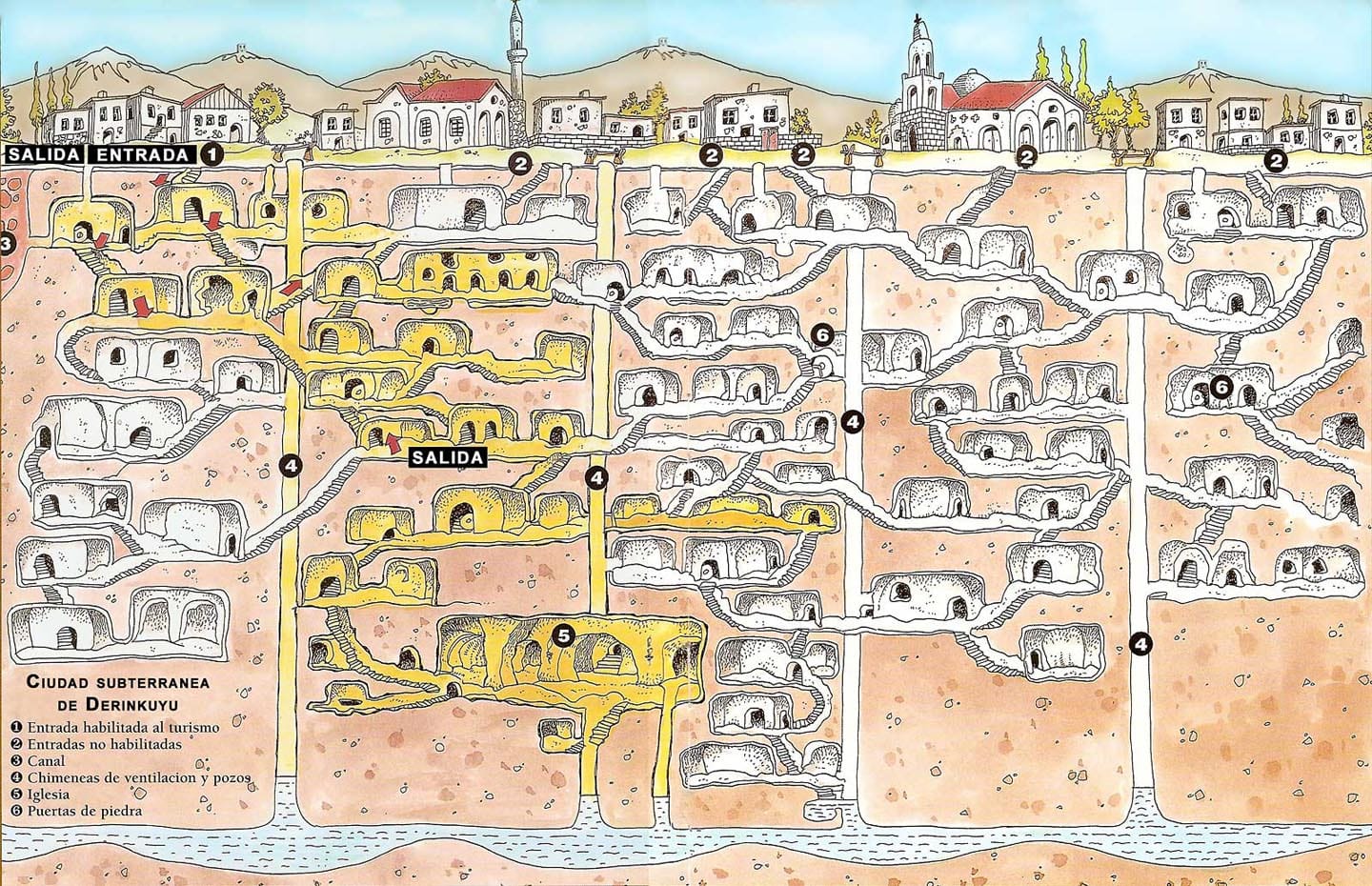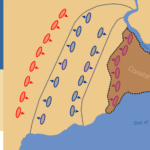Get ready to journey into the mysterious realm of Derinkuyu Underground City with our interactive map! Imagine exploring Turkey’s ancient hidden gem, where people once found safety in a vast network of underground tunnels, homes, and defenses. Dive into a subterranean adventure where history whispers secrets about survival, innovation, and the origins of this enigmatic city. Join us as we unlock the secrets of the Derinkuyu Underground City Map, revealing Turkey’s remarkable ancient wonder.
Journeying Through Turkey’s Hidden City
Get ready for an adventure! We’re diving deep into the mysterious Derinkuyu Underground City, a hidden world tucked away in Turkey’s Cappadocia region. This isn’t just any city – Derinkuyu is a labyrinth of tunnels and chambers, extending over 278 feet (85 meters) deep, all carved into the soft volcanic rock. It’s an entire city built underground!
Our trusty Derinkuyu Underground City map will be our guide as we navigate its 18 levels. Each level is a testament to the ingenuity and grit of the people who once called this place home. But who were they, and why did they choose to live underground?
A City of Refuge
For centuries, Derinkuyu was more than just a city; it was a colossal underground sanctuary. When invaders approached or religious persecution threatened, thousands sought refuge within its depths. Amazingly, this underground city was designed for long-term living. Clever ventilation shafts, disguised as wells, kept the air fresh, while massive, 10-ton rolling stone doors could seal off entire sections, ensuring everyone inside remained safe and sound.
As we explore Derinkuyu’s depths, we’ll encounter their ancient churches, peek into underground stables, and even wander through subterranean wineries and living spaces. It’s a chance to step back in time and glimpse the daily life of the city’s inhabitants. But did they really have everything they needed to survive, even thrive, underground?
Engineering Marvels
Constructing a city underground, especially one as large and complex as Derinkuyu, was no easy feat. The people who built this city were masters of engineering. They created strategic traps and narrow passages to slow down invaders and hid secret doors throughout the city. They even tapped into an underground river for fresh water, ensuring their survival during times of siege. And let’s not forget the amazing ventilation system we mentioned earlier – a marvel of ancient ingenuity, cleverly designed to keep the air flowing even deep underground.
Using the Map to Unlock Secrets
With our Derinkuyu Underground City map in hand, we can unravel the city’s secrets. We’ll navigate winding tunnels, discover hidden chambers, and piece together the story of this remarkable subterranean world. And if you want a sneak peek before you go, interactive 3D maps and virtual tours offer a taste of the experience from home.
Unanswered Questions
Derinkuyu’s allure extends beyond its physical wonders. Were there other reasons for its creation, beyond refuge and defense? Local legends and folklore whisper tales of the city’s past. Are they more than just stories? Some believe there may be undiscovered levels hidden even deeper underground. The search for answers continues to this day, and each new discovery adds another layer to this ancient marvel’s story.
Derinkuyu Underground City: Unraveling the Mystery of its Builders
While the exact origins of Derinkuyu remain shrouded in mystery, one thing is certain: this subterranean city wasn’t built overnight. Carved deep beneath Cappadocia’s volcanic landscape, Derinkuyu Underground City stands as a testament to ancient engineering and a haven with a story still being uncovered.
Who Were Derinkuyu’s Architects?
The identity of Derinkuyu’s original architects remains a topic of debate among historians. However, evidence suggests a complex history of construction and inhabitation spanning millennia, with contributions from various cultures.
The earliest inhabitants were likely the Phrygians, dating back to the 8th-7th century BC. Their initial mark on this underground world probably involved simpler cave dwellings, taking advantage of the region’s soft volcanic rock.
However, the city we see today likely evolved over centuries. During Roman rule, further expansion and development likely took place. Later, early Christians, particularly during the Byzantine era (4th-15th centuries AD), sought refuge within Derinkuyu’s depths, leaving their own mark on its design. The presence of chapels and religious artifacts supports this theory.
Beyond Survival: A Thriving Society
What’s remarkable about Derinkuyu is that it wasn’t merely a place to hide; it housed a complex society. This wasn’t just about survival—it was about maintaining a way of life even in the face of danger.
The city’s layout reveals much about its inhabitants. Eighteen levels, plunging approximately 85 meters deep, could accommodate up to 20,000 people. Beyond basic shelter, Derinkuyu boasted amenities such as:
- Ventilation Shafts: Provided fresh air and cleverly doubled as wells, ensuring a water supply during sieges.
- Chapels and a Religious School: Underscore the importance of faith and education, suggesting a community that valued more than just physical survival.
- Wine and Oil Presses, Stables, Storage Rooms, Cellars, and Refectories: All point to a functioning society with provisions for daily life, sustenance, and even some comforts.
Piecing Together the Puzzle
The mystery of Derinkuyu’s origins is part of what makes it so intriguing. While we might never know definitively who built it, the evidence suggests a captivating story of cultural collaboration and adaptation. Each group that sought refuge within Derinkuyu’s depths – Phrygians, Romans, early Christians – likely contributed to its growth and evolution.
The city’s layout, the different architectural styles found throughout its levels, and the artifacts discovered within all hint at a blend of influences. It’s a giant, underground puzzle just waiting to be pieced together. Perhaps one day, archaeologists will unearth a lost inscription or a key artifact that will definitively reveal the secrets of its builders. Until then, we can only marvel at the ingenuity and resilience of the people who created this extraordinary underground world.
Derinkuyu Bathrooms: Beyond Survival, Unveiling Daily Life
While Derinkuyu’s defensive features and ability to house thousands captivate the imagination, it’s crucial to remember that this was not just a fortress; it was a city. People didn’t just survive within Derinkuyu’s depths – they lived. And a crucial aspect of understanding their daily lives involves exploring the often-overlooked details, like the presence of bathrooms.
Eighteen levels deep, Derinkuyu housed up to 20,000 people, showcasing complex societal structures and resource management. This wasn’t just about squeezing into tight spaces; it was about maintaining a level of sanitation and normalcy in extraordinary circumstances.
Derinkuyu’s Infrastructure – A Closer Look
To truly grasp the significance of bathrooms in Derinkuyu, we need to understand the city’s broader infrastructure. Beyond just hiding, the city contained:
- Living Quarters: Homes carved into the rock, often multi-family dwellings.
- Resource Management: Evidence of stables, areas for food storage, wineries, and even oil presses points to a level of self-sufficiency and planning.
- Community Spaces: Going beyond mere survival, Derinkuyu had chapels, areas that might have served as schools, and meeting areas – signs of a community that maintained its social and spiritual life.
- Defense: The ingenious ventilation shafts, disguised as wells, and the formidable rolling stone doors speak to a constant need for security.
All of this points to a long-term, self-sufficient way of life, not just a temporary solution for riding out a siege. And within this context, the existence of bathroom facilities becomes not just believable, but essential.
The Bathroom Mystery
The presence of “bathrooms” within Derinkuyu is confirmed by historical sources. However, the exact details – their design, number, water management systems – remain a subject of ongoing research.
This lack of concrete information, rather than being a setback, offers a unique opportunity for exploration. It’s a puzzle waiting to be solved, adding to the allure of this already fascinating city.
Sanitation: A Sign of Sophistication
The very existence of bathroom facilities in Derinkuyu reveals a critical aspect of its inhabitants: they understood the importance of sanitation. For a population of that size, living in such close quarters, hygiene would have been crucial for preventing disease outbreaks.
This raises fascinating questions for further research:
- Water Sourcing and Waste Disposal: How was water brought into the city’s depths, and how did they manage waste?
- Variations in Facilities: Did bathroom facilities differ between social classes within Derinkuyu?
- Comparisons to Other Civilizations: How did Derinkuyu’s sanitation practices compare to those of other ancient civilizations?
The discoveries made in Derinkuyu, particularly the presence of something as seemingly mundane as bathrooms, challenge our understanding of ancient civilizations and their ability to not just survive, but thrive in challenging environments. It reminds us that even in the face of danger and uncertainty, the human need for community, for normalcy, persists. The story of Derinkuyu’s bathrooms is more than just a footnote in its history; it’s a testament to the resilience and ingenuity of the human spirit.
[Please provide the collection of trending article titles from your competitors so I can help you choose the most effective title for this section].
The Enigma of Derinkuyu’s Silence
Once a bustling subterranean metropolis sheltering up to 20,000 souls, Derinkuyu underground city now stands eerily quiet. Its labyrinthine tunnels whisper tales of ancient lives – stories of ingenuity, resilience, and community – yet the reason for its abandonment remains shrouded in mystery. Rediscovered in 1963, Derinkuyu invites exploration not only of its physical depths but also of the historical events that led to its creation and eventual desertion.
A City Forged by Crisis
To understand Derinkuyu’s abandonment, we need to revisit its origins. The earliest evidence points to the Phrygians, who likely carved the first basic dwellings into the region’s soft volcanic rock around the 8th-7th century BC. Over time, Derinkuyu saw expansion by various civilizations, each adding their own chapters to its story.
The Byzantines, facing the looming threat of Arab raids during the Arab–Byzantine wars (780-1180 AD), are believed to have significantly expanded the city. It was during this time that Derinkuyu likely reached its peak, becoming a refuge for thousands seeking safety within its depths.
Clues Left Behind
Derinkuyu’s layout offers a glimpse into its inhabitants’ lives and the constant threat they faced. The city’s ingenious design wasn’t just about creating living spaces; it was about survival.
- Eighteen Levels Deep: Descending 85 meters, the city provided ample space for its inhabitants, livestock, and resources.
- Defensive Features: Massive rolling stone doors could seal off sections, while concealed entrances and strategically placed ventilation shafts added to its defenses.
- Self-Sufficiency: Wells provided water, while storage rooms, stables, and even wineries and olive presses ensured the population could sustain itself during prolonged periods underground.
This meticulously planned city, however, went silent sometime after the last known inhabitants, Cappadocian Greeks, evacuated the region in 1923 during the population exchange between Greece and Turkey.
Theories and Speculations
While the exact reason for Derinkuyu’s abandonment remains unknown, several theories attempt to explain this historical puzzle:
- Diminished Threats: As the Byzantine Empire declined and the political landscape shifted, the need for underground refuge might have lessened, leading people to return to life aboveground.
- Environmental Factors: A shift in climate, prolonged drought, or other environmental changes could have made the region less hospitable, forcing inhabitants to relocate.
- Migration for Opportunity: The Cappadocian Greeks might have chosen to migrate for economic opportunities or improved living conditions elsewhere.
Unraveling the Past
Derinkuyu underground city, with its intricate network of tunnels and chambers frozen in time, serves as a poignant reminder of the ingenuity and resilience of its ancient inhabitants. While we may never know the precise reason for its abandonment, the mystery surrounding its silence only adds to the allure of this subterranean marvel. Exploring Derinkuyu is about more than just walking through ancient tunnels; it’s about connecting with the human stories etched into its walls – stories of survival, adaptation, and ultimately, the passage of time.
Internal Links Used:
- [https://www.lolaapp.com/dashrath-manjhi]
- [https://www.lolaapp.com/drone-north-sentinel-island]
- [https://www.lolaapp.com/ducking-stool]
- Unlock Water’s Symbolism: A Cross-Cultural Exploration - April 20, 2025
- Identify Black and White Snakes: Venomous or Harmless? - April 20, 2025
- Unlocking Potential: Origins High School’s NYC Story - April 20, 2025
















3 thoughts on “Derinkuyu Underground City Map: Exploring Turkey’s Ancient Subterranean Marvel”
Comments are closed.